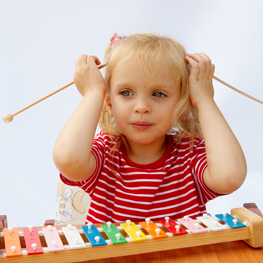
Before I became a parent, I remember sending my nephew a shiny red fire engine as a present. The fire engine had great play value with doors that opened and closed, as well as a set of hoses that could be rolled out and retracted. In addition, the toy emitted an ear-splitting siren that was extremely close to the real thing.
At the time I remember laughing with my sister-in-law about the irritating siren and she proceeded to get even with me when I had children by sending my kids equally loud toys. Like many parents, we found the noisy toys annoying, but I don’t think we understood how dangerous they were to our child’s hearing health.
Every day children experience sound in their environment. Normally, these sounds are at safe levels that don’t damage their hearing. However, repeated and extended exposure to loud noise is one of the most common causes of Noise-Induced Hearing Loss or NIHL. Parents need to realize that every time a child holds a loud toy to their ear, they may be permanently damaging the delicate hair cells in their inner ear. The damage might not be noticeable right away, but over time, our children’s hearing is being impacted by a noisy world that also includes traffic noise, thundering sporting events and loud music from personal music players. Is it any wonder that it is now estimated that 1 in 5 children between the ages of 12 and 18 has some level of hearing loss?
The consequences of hearing loss can be devastating, but particularly for children. The Centers for Disease Control and Prevention (CDC, 2011) report that even a small degree of hearing loss can affect a child’s speech and language comprehension. Hearing loss can also impact a child’s classroom learning and social interaction with their peers.
Sound is measured in units called decibels or dB. A whisper is 30 decibels and a regular conversation is around 60 decibels. Mowing your grass with a gas powered lawnmower can expose you to 100 decibels of sound. In Canada, regulations under the Canadian Consumer Product Safety Act states that a toy “must not make or emit noise of more than 100 dB when measured at the distance that the toy would ordinarily be from the ear of the child who is using it.”
The obvious problem with this is that children don’t always play with toys in their intended manner. Young children, in particular, will often bring toys close to their face and ears as part of play. This means that the danger of noisy toys is even greater than the 100 decibel level implies. A toy which exposes a child to 100 decibels when played at arm’s length can expose them to 120 dB of sound when held to their ear. That’s equivalent to the sound of a jet plane taking off.
When it comes to buying toys, parents, grandparents and caregivers need to rely on their own common sense to protect children’s hearing.
Here are some hints to help keep things safe:
1. Listen to a toy before you purchase it. If a toy sounds loud in the store, it will be loud at home.
2. Consider downloading a decibel meter app to your smartphone and get a reading on a toy before you head to the checkout. Reconsider anything that reads over 85 dB. (There are several good decibel apps out there, but I like Decibel Meter, which you can download for free.)
3. Look for toys with volume controls and on/off switches.
4. Supervise your child when they are playing with a toy that emits sound and make sure that they play with it in the appropriate way.
5. Teach your child how to safely play with a toy with sound. Teach them not to place the toy near their head and ears.
Remove the batteries from a noisy toy.
6. If all else fails, get out the duct tape and put it over the speaker. It may not look pretty, but it will allow the child to continue to play with the now much quieter toy.
Cammie is the Manager of Hearing Services at Deaf and Hear Alberta. For more information on their programs and services, contact 403-284-6200 or visit www.deafandhearalberta.ca.
Calgary’s Child Magazine © 2024 Calgary’s Child